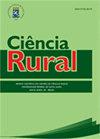脑梗死和血栓性脑膜脑炎小牛由于念珠菌病
IF 0.9
4区 农林科学
Q3 AGRONOMY
引用次数: 0
摘要
摘要:我们报道了一例由念珠菌病引起的脑梗死和血栓性脑膜脑炎,发生于7个月大的小牛。死亡发生在患者出现冷漠、发热和头部向左侧偏3天后。大脑的宏观变化包括端脑半球的不对称;右半球肿大,引起小脑疝。右侧枕叶表面可见局部广泛的红色区域。在固定脑的横截面上,病变显示为广泛的、红棕色的、柔软的或空化的区域,影响从丘脑到小脑的白质和灰质,并压迫下皮层结构。组织学上表现为急性、合并、多灶性坏死性化脓性脑膜脑炎,伴血管炎、充血、血栓形成、水肿、梗死和病灶内真菌菌丝。通过病理改变、制剂的染色和形态特征及免疫组织化学诊断念珠菌病所致脑梗死和血栓性脑膜脑炎。牛的脑梗死和血栓性脑膜脑炎可由念珠菌感染引起的血管病变引起;虽然不常见,但该病例表明,念珠菌病应列入牛严重脑损伤的鉴别诊断清单。本文章由计算机程序翻译,如有差异,请以英文原文为准。
Cerebral infarction and thrombotic meningoencephalitis in a calf due to candidiasis
ABSTRACT: We described a case of cerebral infarction and thrombotic meningoencephalitis due to candidiasis in a seven-month-old calf. The death occurred three days after the onset of apathy, fever, and the head’s lateral deviation to the left. Macroscopic changes in the brain consisted of asymmetry of telencephalic hemispheres; the right hemisphere was enlarged, causing cerebellar herniation. A focally extensive red area was observed on the surface of the right occipital lobe. At cross-sections of the fixed brain, the lesions revealed to be extensive, red-brown, soft or cavitated areas affecting the white and grey matter from the level of the thalamus to the cerebellum and compressing subjacent structures. Histologically, there was acute, coalescent, multifocal necrosupurative meningoencephalitis, associated with vasculitis, congestion, thrombosis, edema, infarction, and intralesional fungal hyphae. The diagnosis of cerebral infarction and thrombotic meningoencephalitis due to candidiasis was made by the pathological changes, the staining and morphological characteristics of the agent, and immunohistochemistry. The cerebral infarction and thrombotic meningoencephalitis in cattle can result from vascular lesions due to infection by Candida sp.; although uncommon, this case demonstrated that candidiasis should be part of a list of differential diagnoses of severe brain injuries in cattle.
求助全文
通过发布文献求助,成功后即可免费获取论文全文。
去求助
来源期刊

Ciencia Rural
AGRONOMY-
CiteScore
1.70
自引率
0.00%
发文量
233
审稿时长
2-4 weeks
期刊介绍:
The purpose of Ciência Rural is to publish the results of original research, note and reviews which contribute significantly to knowledge in Agricultural Sciences. Preference will be given to original articles that develop news concepts or experimental approaches and are not merely repositories of scientific data. The decison of acceptance for publication lies with the Editors and is based on the recommendations of Editorial Comission, Area Committee and/ or ad hoc reviewers. The editors and reviewers are external to the institution.
 求助内容:
求助内容: 应助结果提醒方式:
应助结果提醒方式:


